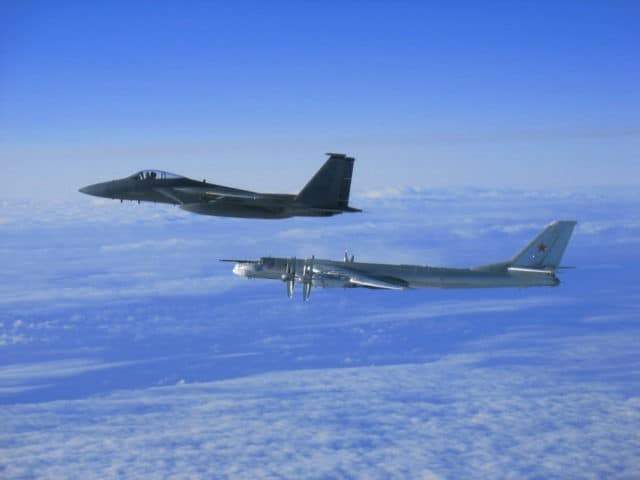Japan Intercepts Two Nuclear-Capable Russian Bombers over Sea of Japan

Japan’s air force recently deployed F-15 fighter jets to intercept two Russian nuclear-capable Tupolev Tu-95MS bombers flying over the Sea of Japan, Russia’s Interfax news agency reported Thursday.
“Two Tu-95MS strategic bombers of the long-range aviation conducted a routine flight over the neutral waters of the Sea of Japan and the north-western part of the Pacific Ocean… The duration of the flight exceeded nine hours. At certain stages of the flight, the Russian strategic bombers were escorted by the Japanese air force’s F-15 fighters,” Russia’s Ministry of Defense said in a statement issued March 11.
The Sea of Japan is a marginal sea separating the Russian mainland from the Japanese archipelago. Japan claims sovereignty over four of the southernmost Kuril Islands, an island chain administered by Russia. The Japanese island of Hokkaido is located at the Kuril Island chain’s southern end, while the Russian Kamchatka Peninsula is located at the chain’s northern end.
Russia insists a 1945 treaty known as the Yalta Agreement, signed by the western Allies at the end of WWII, grants Moscow sovereignty over the Kuril Islands.
“The U.S., which underwrote the treaty and even helped equip Soviet Red Army troops to take the islands, has since changed its policy and supports the Japanese claims,” Russia’s state-run RT News recalled Thursday.
“The Tu-95 is a four-engine long-range strategic bomber developed by Russian aerospace and defense company Tupolev Design Bureau in [the 1950s. The current version is the Tu-95MS, which entered service in 1984,” Russia’s state-owned Sputnik News agency noted Thursday in its report on Russia’s latest incursion into the Sea of Japan.
The Tu-95 is also as the “Bear” for producing one of the loudest sounds of any military aircraft in operational use today. The Bear owes its distinctive sound to its unique engines and propeller blades, which reportedly move faster than the speed of sound. Russia’s military commissioned the aircraft during the Cold War, making its public debut in 1955. It is still considered “fundamental to Russia’s strategic aviation” today, according to RT News.
“The Tu-95 can be used effectively as a cruise missile platform. It can fire missiles thousands of kilometers away from the target and return safely to base,” according to RT. Russia’s air force uses the Tu-95 for a wide variety of missions, including maritime reconnaissance, signal jamming, and intercepting radio signals. Tu-95 missions can last up to 20 hours non-stop if the aircraft is refueled mid-air.
Photo: https://www.norad.mil/Images/igphoto/2000017151 NORAD











